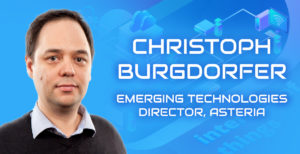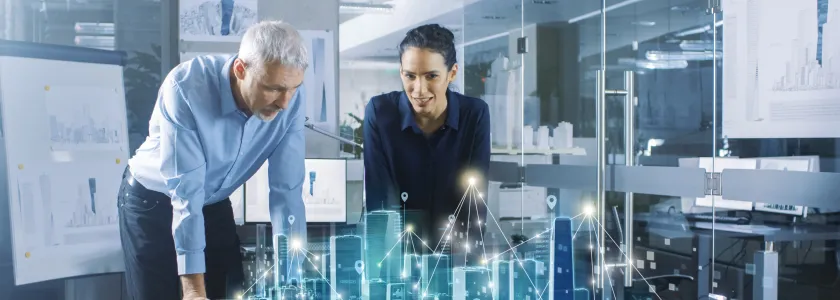Christoph Burgdorfer is the Emerging Technologies Director for Asteria. This spring, Christoph participated in a TechDebates.org forum in London, where the panel discussed how the physical and digital worlds are coalescing. Christoph and I were able to explore the topic from a slightly different perspective after the TechDebate.
Could you start by explaining a little bit about Asteria and the IoT solutions you are creating?
CHRISTOPH: Asteria is a Japanese publicly listed company that’s well-known for its application integration software Asteria Warp. In simplistic terms, Asteria provides software that serves as a middle layer or hub to manage data flowing from many enterprise software solutions being utilized within organizations. Around two or three years ago, Asteria decided to use our data integration expertise to 
Because the retail industry is in the middle of significant change and struggle, can we talk about how new applications of technology might benefit the retail industry?
CHRISTOPH: Amazon Go is a great example of what some new retail spaces will look like. Consumers can go into a shop, identify themselves with an app, take things off the shelf, and walk out. Because everything in the shop is so connected, Amazon knows who has walked around, where, which products have been purchased, who purchased them, and other intelligence to help them better stock,
merchandise, and operate the shop in the future. Customers aren’t confronted with waiting in lines or other inconveniences because the entire process is automated.
It’s no secret that much more shopping is happening online, and many retailers are struggling with falling store foot traffic and declining sales. But retailers can make the experience in their physical stores distinctly different from and complementary to online shopping experiences. For some retailers, the goal of their physical stores might not be for customers to come to the store to buy products but
rather to experience them.
Especially in luxury, high-ticket categories, retailers have the opportunity to become playful and generate a great deal of engagement with their brands to build loyalty. For example, maybe customers try on clothing, jewelry, or shoes utilizing augmented and virtual reality tools. Maybe in furniture stores, customers redesign a room or their entire home and see exactly how the new furniture they are
considering will look in the room, how new artwork will look on the walls, and so on.
Optimizing customer traffic is another opportunity for retailers to use sensors and other data collection strategies. How long are customers spending in the shop? Which shelves are they looking at? Which products are they trying? If they’re trying the products, are they also buying? What is the correlation between the number of people who walk in front of the store, people who look at the shop window, and people who come into the store? These insights would allow retailers to experiment with making changes to the front window and calculating the results of those changes on store traffic.
For quite some time, digital retailers have been doing this kind of experimentation to make data-based decisions. Brick-and-mortar retailers now have a similar opportunity. Generally, I think the more connected a business is, the more value can be extracted from it. So, there is a huge opportunity in making physical spaces as connected as possible.
Are there areas where technology advancement is necessary to further facilitate the IoT? Are there technology bottlenecks slowing IoT progress?
CHRISTOPH: I think the bottlenecks are not so much within the technology realm but people’s habits. It’s easy to develop and deploy a new technology. Almost anything you can think of is now possible with technology, but the question is, can you change the habits of people?
First, can we get people to rethink what physical space is in the first place? What does it truly mean to create a smart space? How can we think in innovative ways? Many professionals who are designing spaces today don’t even understand what’s possible, so we need to change that. Second, we must change the habits of consumers. How do consumers interact with each other in smart spaces? How do
consumers interact with businesses? Are there ways to allow customers to engage with each other and your brand more deeply by creating well-designed smart spaces?
Self-driving cars are always an example I come back to when I think of the changes being ushered in by technology. How comfortable are people sitting in a car that has no steering wheel that will drive them around? It will take many people a long time to overcome their desire to control the car. This same resistance to change is present within many areas of technology adoption.
In terms of the actual technological hurdles that need to be overcome, I think many things are technically possible. Unfortunately, there’s often red tape, especially if you work with larger organizations that create real bottlenecks for executing many of these new opportunities. Moving large organizations fast enough is a real issue.
While I don’t see technological hurdles on the software side, but battery life remains a challenge. With a multitude of devices that will be placed essentially everywhere, we need much longer battery life.
What ethical or societal challenges is the IoT introducing?
CHRISTOPH: Most people think of privacy issues as being the big ethical challenge we are facing. It is true that privacy and data management practices are challenges we must manage. However, the environmental impact of the multitude of batteries being used in sensors and other devices is a big issue in my mind. How can we make those sensors more environmentally friendly? Can we make them recyclable? In agricultural applications like detecting soil moisture, how can we ensure that they are not damaging the earth with leaking batteries or other waste products?
It’s important that we think about the full life cycle of these products. We need to design technologies with a plan of not only how they will start their lives but also how they end them. At some point, every device needs to be disposed of.
Where do you think the IoT will take us within the next five years?
CHRISTOPH: I think one of the biggest changes within the next five years will be the mind-sets of people shifting. Many of these technologies that truly connect the digital and physical spaces still seem gimmicky—almost like science fiction. I think in the next five years there will be significant shifts in the perception of how humans and technology can and will interact in the future.
I hope to see much better battery technology, both in terms of batteries lasting longer and their environmental friendliness. Hopefully, autonomous vehicles will hit the market for the first time. Additionally, I hope to see more smart spaces like smart buildings, smart meeting rooms, and smart hospitals.
I think we will make progress on one of the biggest challenges of our time from my perspective—the aging population People are getting older, becoming lonelier, and becoming more isolated. Technology can enable elderly people to stay connected with their families and perhaps be able to stay in their own homes longer.
IoT Consulting – How Sphere Can Help
Are you ready to capitalize on the immediate and potential future value of IoT? Get in touch with Sphere today.
Through integrating sensors, providing insight, and assisting customers in choosing the best platform, Sphere successfully delivers IoT solutions to users across many different industries. Sphere’s extensive experience and exceptional business value helps to improve efficiency, increase revenues, and reduce IoT development costs.
In order to help clients meet current business needs as well as create a foundation for economic growth and competitiveness, Sphere IoT consulting experts can define and implement solutions, design and develop products, connect and communicate efficiently, analyze business insights, and improve decision making.
Sphere’s IoT software development team offers experience in delivering connected solutions, IoT innovation strategy, developing cost effective solutions, and collecting and analyzing large amounts of data.





